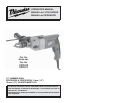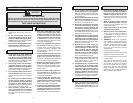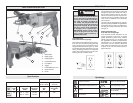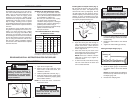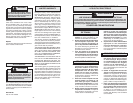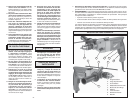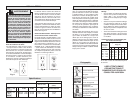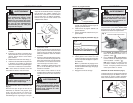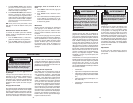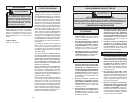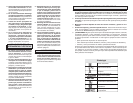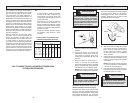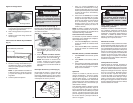
8 9
WARNING
To reduce the risk of injury, wear
safety goggles or glasses with side
shields. Unplug the tool before
changing accessories or making
adjustments.
OPERATION
1. For drilling, turn the hammer-drill lever
towards the drill symbol .
2. For hammer-drilling, turn the
hammer-drill lever towards the
hammer symbol .
NOTE: To engage the hammering
mechanism, maintain pressure on
the bit. When pressure on the bit is
released, the hammering action will
stop.
Selecting Action (Fig. 5)
MILWAUKEE Hammer-Drills have two set-
tings: drilling and hammer-drilling.
Fig. 6
Forward
Reverse
1. For forward (clockwise) rotation, push
the forward/reverse lever to the left
(when viewed from the back of the tool)
as shown.
2. For reverse (counterclockwise) rotation,
push the forward/reverse lever to the
right (when viewed from the back of the
tool) as shown. Allow the motor to come
to a full stop before reversing.
NOTE: When hammer-drilling, use the tool
in forward rotation (clockwise) only.
Selecting Speed
The speed can be changed when the tool
is at a complete stop or running under no
load.
1. For low speed (up to 1350 rpm), turn
the speed selector to position 1.
2. For high speed (up to 2500 rpm), turn
the speed selector to position 2.
Starting, Stopping & Controlling Speed
1. To start the tool, pull trigger.
2. To stop the tool, release trigger.
3. To vary the speed, increase or decrease
pressure to trigger. The further the trig-
ger is pulled, the greater the speed.
Operating
Position the tool, grasp the handles fi rmly
and pull the trigger. Always hold the tool
securely using both handles and maintain
control. This tool has been designed to
achieve top performance with only moderate
pressure. Let the tool do the work.
If the speed begins to drop off when drilling
deep holes, pull the bit partially out of the hole
while the tool is running to help clear dust.
Do not use water to settle the dust since it
will clog the bit fl utes and tend to make the
bit bind in the hole.
Drilling in Wood, Composition Materials
and Plastic
When drilling in wood, composition materials
and plastic, select the drill operating mode.
Start the drill slowly, gradually increasing
speed as you drill. Select low speeds for
plastics with a low melting point.
Drilling in Metal
When drilling in metal, select the drill operat-
ing mode. Use high speed steel twist drills
or hole saws. Use a center punch to start
the hole. Lubricate drill bits with cutting oil
when drilling in iron or steel. Use a coolant
when drilling in nonferrous metals such as
copper, brass or aluminum. Back the ma-
terial to prevent binding and distortion on
breakthrough.
Drilling in Masonry
When drilling in masonry, select the ham-
mer-drill operating mode. Use high speed
carbide-tipped bits. Drilling soft masonry
materials such as cinder block requires
little pressure. Hard materials like concrete
require more pressure. A smooth, even fl ow
of dust indicates the proper drilling rate. Do
not let the bit spin in the hole without cut-
ting. Do not use water to settle dust or to
cool bit. Do not attempt to drill through steel
reinforcing rods. Both actions will damage
the carbide.
Selector Lever
Fig. 5
Using Forward/Reverse Lever (Fig. 6)
The forward/reverse lever can only be adjust-
ed when the trigger is not pressed. Always
allow the motor to come to a complete stop
before using the forward/reverse lever.
APPLICATIONS
WARNING
To reduce the risk of electric shock,
check work area for hidden pipes
and wires before drilling.
Maintaining Tools
Keep your tool in good repair by adopting a
regular maintenance program. Before use,
examine the general condition of your tool.
Inspect guards, switches, tool cord set and
extension cord for damage. Check for loose
screws, misalignment, binding of moving
parts, improper mounting, broken parts and
any other condition that may affect its safe
operation. If abnormal noise or vibration oc-
curs, turn the tool off immediately and have
the problem corrected before further use.
Do not use a damaged tool. Tag damaged
tools “DO NOT USE” until repaired (see
“Repairs”).
Under normal conditions, relubrication is not
necessary until the motor brushes need to
be replaced. After six months to one year,
depending on use, return your tool to the
nearest MILWAUKEE service facility for the
following:
• Lubrication
• Brush inspection and replacement
• Mechanical inspection and cleaning
(gears, spindles, bearings, housing,
etc.)
• Electrical inspection (switch, cord,
armature, etc.)
• Testing to assure proper mechanical and
electrical operation
WARNING
To reduce the risk of injury, always un-
plug your tool before performing any
maintenance. Never disassemble the
tool or try to do any rewiring on the
tool's electrical system. Contact a
MILWAUKEE service facility for ALL
repairs.
MAINTENANCE



